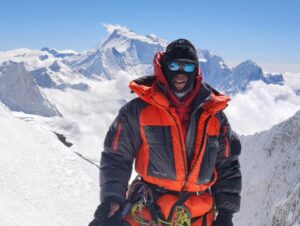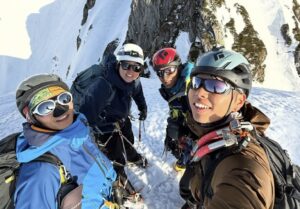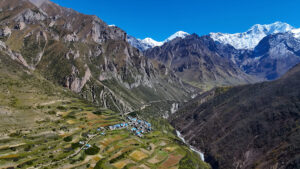On May 4, 2022, Spanish climbers Tomeu Rubi and Pep Roig made an alpine-style ascent of the southeast face of Dolma Kang (6,332m) in Rolwaling, Nepal. According to the two climbers, this may have been the first alpine-style climb on this face.
The goal
Rubi told the Spanish blog Barrabes that they initially planned to climb a virgin 6,000’er in alpine style. But after consulting the restrictions imposed by the Nepalese government, they were left considering two peaks: 6,125m Beding Go and 6,332m Dolma Kang.
They finally decided on Dolma Kang, which is sort of a subpeak of beautiful Gaurishankar (7,146m), which we recently covered in-depth. Dolma Kang is in the Rolwaling Himal of Nepal, near the border with Tibet.

Roig and Rubi on Dolma Kang in alpine-style. Photo: Tomeu Rubi/Pep Roig
On April 30, Roig and Rubi approached the southeast wall of Dolma Kang. The approach was not easy, with some complicated sections. At 4,900m, they found some platforms where they could pitch their tents, as well as a discarded wooden board among the rocks. There appeared to be an inscription on it that read, “2017”.
The weather was bad, with fog obscuring the southeast wall. The two climbers decided to descend to Beding, a small village by the Rolwaling River. Here, they asked about the wooden board and any 2017 expedition, but no one seemed to know anything.

Early in the climb. Photo: Tomeu Rubi/Pep Roig
The climb
Though Rubi says that their weather forecasts were unreliable, May 3 looked clear, and the duo wanted to take advantage. On May 2, they climbed 1,200m over “uncomfortable terrain” to a small level area that they had spotted two days earlier. At last, they could see the southeast face of Dolma Kang.
“We found it strange that no one had climbed or tried this wall before,” recalled Rubi.

Climbing toward the ridge. Photo: Tomeu Rubi/Pep Roig
On May 3, they set off at 3:30 am, ascending 1,000m and passing through a snowy couloir. The average incline in the corridor was about 65°, with vertical ledges of rotted ice. The last 300m of this section was even steeper mixed terrain.
They stopped to pitch their tent on a narrow ledge. The tent was larger than the available space and they had to sleep squashed together. Precariously perched, they didn’t get much rest.

After the first bivouac. Photo: Tomeu Rubi/Pep Roig
Summit day
On May 4 at 5:30 am, they began to climb the last 400m to the summit. The terrain was more technical than the day before. As they climbed, they came across old ropes mounting the spur ahead of them. They now realized that they were not the only climbers to have taken this route. Rubi and Roig were not happy to see so much rope and material abandoned on the mountain.
At noon the same day, they reached the summit. Clouds began to form, so they had to quickly make their descent.

Tomeu Rubi and Pep Roig descend after summiting Dolma Kang. Photo: Tomeu Rubi/Pep Roig
Their way down led at first a glacier full of seracs and crevasses. They stopped often, waiting for the clouds to let up for a few minutes so that they could see the route ahead.
They had intended to reach the platforms where they had spent the night two days before, but visibility had decreased to only 20m. At 4 pm they decided to stop and pitch their tent at around 5,900m. The next day, May 5, the clouds were gone and they were finally able to descend the final sections.

Pep Roig arrives at the first bivouac spot. Dolma Kang is a dangerous mountain, full of avalanches, cornices, and sharp ridges. Photo: Tomeu Rubi
Other ascents and expeditions
The mysterious wooden board and the ropes high on the mountain encouraged us to examine previous ascents of Dolma Kang.
Officially, Dolma Kang has been climbed by 21 people (including Rubi and Roig), over six expeditions. There were two expeditions in 1980, one in spring, one in autumn, and then expeditions in 1984, 1995, 2008, and 2022. Of the 21 summiters, only one used supplemental oxygen.
Interestingly, except for Rubi and Roig, none of these expeditions had Dolma Kang as their main objective. The other expeditions had aimed to climb Gaurishankar using a route that passes through the top of Dolma Kang.
Between 2008 and 2014, no climbing permits were issued for Dolma Kang.

On the east-northeast ridge of Dolma Kang during the 2008 attempt on the southeast ridge of Gaurishankar. The camp marked is at 5,500m. Other key points: A) Part of Melungtse in Tibet; B) Ripimo Shar; C) Drangnag Ri; D) Kang Nachugo behind Beding Go; E) Chekigo; F) Unnamed Peak 5,840m, climbed in 2017. Photo: David Goettler
What happened in 2017?
The wooden board that Rubi and Roig found among the rocks probably belongs to an expedition led by Norwegian Tore Sunde-Rasmussen. Sunde-Rasmussen, Dawa Tashi Sherpa, Tamding Sherpa, and Thundu Sherpa attempted Dolma Kang in 2017.
Sunde-Rasmussen was not well acclimatized when he arrived by helicopter at base camp, so he was ill at the start of the expedition.

On the south face of Unnamed Peak 5,840m. E marks a characteristic brown rock band just below the crest, and F is the highest point. Photo: Tore Sunde-Rasmussen
They did not summit Dolma Kang but did summit an unnamed peak of about 5,840m, on November 5. This peak is on the long east ridge of Dolma Kang. This ridge runs along the Nepal-Tibet border toward Beding Go (6,125m). Sunde-Rasmussen used bottled oxygen intermittently, from approximately 5,800m to the summit, during the descent, and in base camp the night after the summit.
This team believed that they had summited Dolma Kang, but a detailed analysis of their photos by The Himalayan Database confirmed that they had instead summited an unnamed 5,840m peak.
Who left the old ropes spotted by Rubi and Roig?
These could have been left by an Australian expedition, although we can’t know for sure. What we do know is that in the spring of 1980, an Australian team under the leadership of Patrick Alexander Cullinan approached the peak from the east. The team, climbing without bottled O2, included 10 Australians and two Sherpas. They intended to climb Gaurishankar.
The party climbed a steep gully on the left side of the southeast face of Dolma Kang to reach the upper south ridge, which they followed to the summit of Dolma Kang on April 11, 1980. They fixed rope only from 5,060m to 5,320m.

In 2008 David Goettler and Peter Anzenberger climbed a new route alpine style on Dolma Kang. XY marks the summit of Dolma Kang. Photo: David Goettler
During the climb, they faced constant avalanches and continuous bad weather. The difficult ridge was very corniced, with a huge rock barrier that looked like a brick wall halfway to the south summit of Gaurishankar. Running out of time and concerned about the weather, they stopped at the summit of Dolma Kang.
The summiters were Graham John Brammer, Paul Malcolm, Ian Richards, and Shambu Tamang Sherpa on April 11, 1980. Two days later, Wayne Carroll, Patrick Alexander Cullinan, Michael William Hardless, and Jan Remynse also summited.
According to Cullinan, on April 3, before reaching the summit, climber Barry Young almost died. After detaching himself from the fixed rope, he caught one of his front points in the strap of the other crampon and fell 365m down the gully. He injured both legs and suffered a mild concussion.
“Only the quick thinking of Anu Sherpa and the heavy snowfall the previous day saved his life,” Cullinan recalled.
The Japanese expedition of 1980
In the fall of 1980, 35 Japanese climbers and three Sherpas set out to climb Gaurishankar.
On October 15, 25-year-old Ryoichi Otsubo and 28-year-old Takashi Ozaki reached the summit of Dolma Kang. They pushed a little further along the southeast ridge to the top of Gauri, before retreating from around 6,400m because of bad weather.
The expedition did not use bottled O2.

David Goettler and Peter Anzenberger climbing on the sharp ridge on Dolma Kang in 2008. Photo: David Goettler
8,000m of fixed rope in 1984
Four years later, in the fall of 1984, some of the Japanese climbers from 1980 returned. This time, there were fewer climbers: 13 Japanese and two Sherpas. Again, they intended to climb Gaurishankar.
They re-climbed the southeast face of Dolma Kang, fixing some 8,000m of rope, and then completed the southeast ridge to the top of Gauri. On October 1, 1984, Atsushi Furuhata, Yasuhira Saito, Kiyohiko Suzuki, Kazuo Yamamoto, Ang Dawa Tamang, and Nima Dawa Tamang summited Dolma Kang. Only Suzuki used supplemental oxygen.
It is more likely that the fixed ropes that Rubi and Roig saw belonged to this party.
The British expedition, 1995
In 1995, a UK team reached the summit of Dolma Kang by attempting Gauri’s southeast ridge. The British party, under the leadership of Nicholas Harper, consisted of seven climbers.
They put in fixed ropes from their advanced base camp at 5,100m to their second bivi at 5,800m, and then to the summit of Dolma Kang.
A new route in alpine style, 2008
In the autumn of 2008, German climbers David Goettler and Peter Anzenberger attempted Gaurishankar. They climbed in light alpine style, without O2.

David Gottler and Peter Anzenberger’s new route on Dolma Kang in 2008. XY shows the summit. Photo: David Gottler
Goettler and Anzenberger established a new route by following the east-northeast ridge from the south. On October 24, 2008, they reached their summit. Goettler told Explorersweb that at the time, they did not know it was Dolma Kang, or even that it was an independent mountain. They called it “XY” in their photos.
After their climb, they removed all their gear, tents, and rope from the mountain.
Interestingly, none of the successful expeditions, except this latest one in 2022, had Dolma Kang as its main objective.






